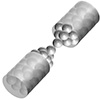(Nanowerk News) At the nanoscale, the laws of classical physics suddenly become inadequate to explain the behavior of matter. It is precisely at this juncture that quantum theory comes into play, effectively describing the physical phenomena characteristic of the atomic and subatomic world. Thanks to the different behavior of matter on these length and energy scales, it is possible to develop new materials, devices and technologies based on quantum effects. A real quantum revolution that promises to innovate areas such as cryptography, telecommunications and computation. The physics of very small objects, already at the basis of many technologies that we use today without realizing it, is intrinsically linked to the world of nanotechnologies, the branch of applied science dealing with the control of matter at the nanometer scale (a nanometer is one billionth of a meter). This control of the matter at the nanoscale is at the basis of the development of new electronic devices. Among these, memrisistors are considered promising devices for the realization of new computational architectures emulating functions of our brain, allowing the creation of increasingly efficient computation systems suitable for the development of the entire artificial intelligence sector, as recently shown by INRiM researchers in collaboration with several international universities and research institutes (Nature Materials, “In materia reservoir computing with a fully memristive architecture based on self-organizing nanowire networks” and Advanced Intelligent Systems, “Brain‐inspired structural plasticity through reweighting and rewiring in multi‐terminal self‐organizing memristive nanowire networks”). In this context, the EMPIR MEMQuD project, coordinated by INRiM, aims to study the quantum effects in such devices in which the electronic conduction properties can be manipulated allowing the observation of quantized conductivity phenomena at room temperature. In addition to analyzing the fundamentals and recent developments, the review work (Advanced Materials, “Quantum Conductance in Memristive Devices: Fundamentals, Developments, and Applications”) analyzes how these effects can be used for a wide range of applications, from metrology to the development of next-generation memories and artificial intelligence.

